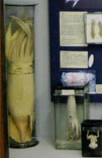
CLASS CEPHALOPODA
Cephalopods – the nautilids, argonauts, cuttlefish, squids and octopuses – are the most highly specialised and organised molluscs. The 600 living species are mostly adapted for a swimming existence although some octopuses live on the seafloor. This class contains the largest invertebrate – the giant squid, Architeuthis - but most specimens are only 6 to 70 cm long including tentacles.
All have well-developed heads projecting into a circle of large prehensile tentacles and arms. Their bodies are greatly lengthened. Only Nautilius spp. have completely formed shells, squids and cuttlefishes have reduced internal shells and octopuses have no shells at all.
Cephalopods are highly specialised predators finding their food by sight with highly developed eyes. Once captured in their tentacles, food is passed to a pair of powerful beak-like jaws, which bite and tear off large pieces of flesh. The food is pulled into the buccal cavity by the radula and then swallowed.
Most cephalopods swim by jet-propulsion rapidly expelling water out of the mantle cavity through a ventral, tubular funnel. The force of the jet propels the animal in the opposite direction. Cephalopods, which use a gas-filled shell to maintain neutral buoyancy (Nautilius, Spirulla and Sepia), are restricted to depths at which the shell strength can withstand the pressure. At greater depths their shells implode.
Cephalopods frequently change colour and patterns: when frightened or angry during courtship or for camouflage. They also escape from predators by producing a ‘smoke screen’ of opaque ink to hide their movements.
Males have a special arm, the hectocotylus, which passes the spermatophore bearing the sperm into the mantle cavity of the female to be near her genital duct opening. Eggs may be attached to the substrate, like these tiny Octopus eggs. They hatch into replicas of the parents like the young Loligo vulgaris, a cuttlefish, and Sepia officinalis, a squid, preserved in these little tubes.
There are two living subclasses:
Subclass Nautiloidea: forms with complete shells: Nautilius and the extinct ammonites;
Subclass Coleoidea: all living cephalopods with a reduced shell or no shell.
|
|
||||||||||||||||||||||||||||||||||||||||||||||||||||||||
Select an area or choose a link for more information.










